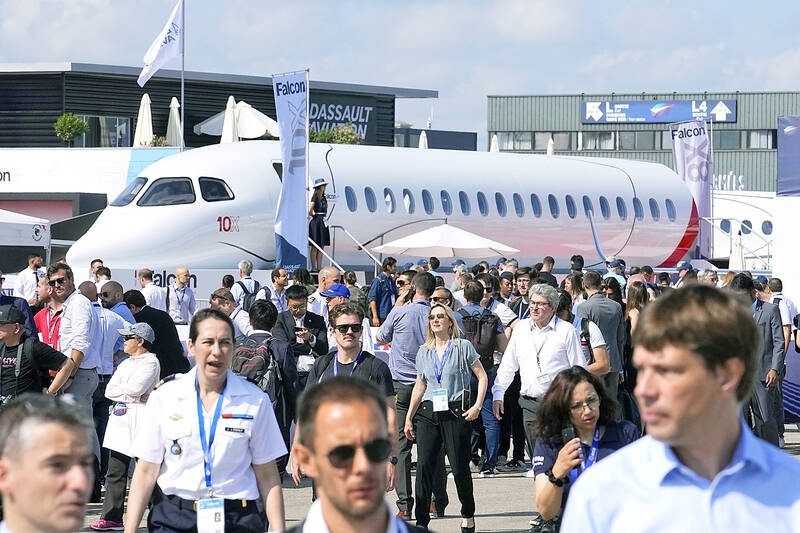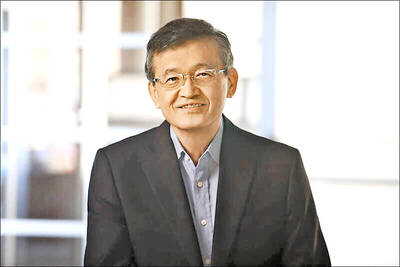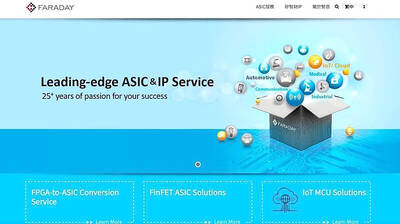When it comes to flying, going green might cost more, and it is going to take a while for the strategy to take off.
Sustainability was a hot topic this week at the Paris Air Show, the world’s largest event for the aviation industry, which faces increasing pressure to reduce the climate-changing greenhouse gases that aircraft spew.
Even the massive orders at the show got an emissions-reduction spin: Airlines and manufacturers said the new planes would be more fuel-efficient than the ones they replace.

Photo: AP
However, most of those planes would burn conventional, kerosene-based jet fuel. Start-ups are working feverishly on electric-powered aircraft, but they would not catch on as quickly as electric vehicles.
“It’s a lot easier to pack a heavy battery into a vehicle if you don’t have to lift it off the ground,” said Gernot Wagner, a climate economist at New York University.
That means sustainable aviation fuel (SAF) has become the industry’s best hope to achieve its promise of net zero emissions by 2050. Aviation produces 2 to 3 percent of worldwide carbon emissions, but its share is expected to grow as travel increases and other industries become greener.
Sustainable fuel accounts for just 0.1 percent of all jet fuel. Made from sources like used cooking oil and plant waste, SAF can be blended with conventional jet fuel, but costs much more.
Suppliers are “going to be able to kind of set the price,” American Airlines Inc vice president Molly Wilkinson said at the air show. “And we fear that at that point, that price eventually is going to trickle down to the passenger in some form of a ticket price.”
With such a limited supply, critics say airlines are making overly ambitious promises and exaggerating how quickly they can ramp up the use of SAF.
The industry even has skeptics: Nearly one-third of aviation sustainability officers in a GE Aerospace survey said they doubt the industry would hit its net zero goal by 2050.
Delta Air Lines Inc is being sued in US federal court by critics who say the carrier falsely bills itself as the world’s first carbon-neutral airline, and that Delta’s claim rests on carbon offsets that are largely bogus.
The Atlanta, Georgia-based airline says the charges are “without legal merit.”
Across the Atlantic, the European Consumer Organisation (BEUC) filed a complaint this week with the EU’s executive arm, accusing 17 airlines of greenwashing.
The group says airlines are misleading consumers and contravening rules on unfair commercial practices by encouraging customers to pay extra to help finance development of SAF and offset future carbon emissions created by flying.
In one case, the group’s researchers found Air France charging up to 138 euros (US$150.33) for the green option.
“Sustainable aviation fuels, they are indeed the biggest technological potential to decarbonize the aviation sector, but the main problem ... is that they are not available,” BEUC senior policy officer Dimitri Vergne said.
“We know that before the end of the next decade — at least — they won’t be available in massive quantities,” and would not be the main source of fuel for planes, Vergne said.
Producers say SAF reduces greenhouse gas emissions by up to 80 percent, compared with regular jet fuel, over its life cycle.
Airlines have been talking about becoming greener for years. They were rattled by the rise of “flight shaming,” a movement that encourages people to find less-polluting forms of transportation — or reduce travel altogether.
The issue gained urgency this year when EU negotiators agreed on new rules requiring airlines to use more sustainable fuel starting in 2025 and rising sharply in later years.
The US is pushing incentives instead of mandates.
A law signed last year by US President Joe Biden would provide tax breaks for developing cleaner jet fuel, but one of the credits is to expire in just two years.
Wilkinson said that was too short to entice sustainable fuel producers and that the credit should be extended by 10 years or longer.
The International Air Transport Association, an airline trade group, said it estimates that SAF could contribute 65 percent of the emissions reductions needed for the industry to hit its 2050 net zero goal.
However, few flights are powered by SAF because of the limited supply and infrastructure.
Just before the Paris Air Show opened, French President Emmanuel Macron announced that France would contribute 200 million euros toward a 1 billion euro plant to make SAF.
Many airlines have touted investments in SAF producers such as World Energy, which has a plant in Paramount, California, and Finland’s Neste Oyj.
United Airlines Holdings Inc plans to triple its use of SAF this year, to 38 million liters — but it burned 13.6 billion liters of fuel last year.
Some see sustainable fuel as a bridge to cleaner technologies, including larger electric planes or aircraft powered by hydrogen, but packing enough power to run a large electric plane would require a fantastic leap in battery technology.
Hydrogen must be chilled and stored somewhere. It could not be carried in the wings of today’s planes, as jet fuel is.
“Hydrogen sounds like a good idea. The problem is the more you look into the details, the more you realize it’s an engineering challenge, but also an economics challenge,” Richard Aboulafia, managing director of aerospace consultancy AeroDynamic Advisory, said at the Paris Air Show. “It’s within the realm of possibility, [but] not for the next few decades.”

Intel Corp chief executive officer Lip-Bu Tan (陳立武) is expected to meet with Taiwanese suppliers next month in conjunction with the opening of the Computex Taipei trade show, supply chain sources said on Monday. The visit, the first for Tan to Taiwan since assuming his new post last month, would be aimed at enhancing Intel’s ties with suppliers in Taiwan as he attempts to help turn around the struggling US chipmaker, the sources said. Tan is to hold a banquet to celebrate Intel’s 40-year presence in Taiwan before Computex opens on May 20 and invite dozens of Taiwanese suppliers to exchange views

Application-specific integrated circuit designer Faraday Technology Corp (智原) yesterday said that although revenue this quarter would decline 30 percent from last quarter, it retained its full-year forecast of revenue growth of 100 percent. The company attributed the quarterly drop to a slowdown in customers’ production of chips using Faraday’s advanced packaging technology. The company is still confident about its revenue growth this year, given its strong “design-win” — or the projects it won to help customers design their chips, Faraday president Steve Wang (王國雍) told an online earnings conference. “The design-win this year is better than we expected. We believe we will win

Chizuko Kimura has become the first female sushi chef in the world to win a Michelin star, fulfilling a promise she made to her dying husband to continue his legacy. The 54-year-old Japanese chef regained the Michelin star her late husband, Shunei Kimura, won three years ago for their Sushi Shunei restaurant in Paris. For Shunei Kimura, the star was a dream come true. However, the joy was short-lived. He died from cancer just three months later in June 2022. He was 65. The following year, the restaurant in the heart of Montmartre lost its star rating. Chizuko Kimura insisted that the new star is still down

While China’s leaders use their economic and political might to fight US President Donald Trump’s trade war “to the end,” its army of social media soldiers are embarking on a more humorous campaign online. Trump’s tariff blitz has seen Washington and Beijing impose eye-watering duties on imports from the other, fanning a standoff between the economic superpowers that has sparked global recession fears and sent markets into a tailspin. Trump says his policy is a response to years of being “ripped off” by other countries and aims to bring manufacturing to the US, forcing companies to employ US workers. However, China’s online warriors